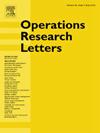固定订单调度与最后期限
IF 0.9
4区 管理学
Q4 OPERATIONS RESEARCH & MANAGEMENT SCIENCE
引用次数: 0
摘要
本文研究了机器必须按照预定的固定顺序进行加工作业的调度问题。给定n个工作,每个工作都有处理时间和截止日期,我们的目标是在满足截止日期和维持订单的同时,尽量减少使用的机器数量。我们表明,当顺序与不增加的松弛、不减少的松弛或不增加的截止日期对齐时,第一次拟合算法是2逼近。一般来说,我们提供一个O(log (n))的近似。本文章由计算机程序翻译,如有差异,请以英文原文为准。
Fixed order scheduling with deadlines
This paper studies a scheduling problem where machines must follow a predetermined fixed order for processing jobs. Given n jobs, each with processing times and deadlines, we aim to minimize the number of machines used while meeting deadlines and maintaining the order. We show that the first-fit algorithm is a 2-approximation when the order aligns with non-increasing slacks, non-decreasing slacks, or non-increasing deadlines. In general, we provide an -approximation.
求助全文
通过发布文献求助,成功后即可免费获取论文全文。
去求助
来源期刊

Operations Research Letters
管理科学-运筹学与管理科学
CiteScore
2.10
自引率
9.10%
发文量
111
审稿时长
83 days
期刊介绍:
Operations Research Letters is committed to the rapid review and fast publication of short articles on all aspects of operations research and analytics. Apart from a limitation to eight journal pages, quality, originality, relevance and clarity are the only criteria for selecting the papers to be published. ORL covers the broad field of optimization, stochastic models and game theory. Specific areas of interest include networks, routing, location, queueing, scheduling, inventory, reliability, and financial engineering. We wish to explore interfaces with other fields such as life sciences and health care, artificial intelligence and machine learning, energy distribution, and computational social sciences and humanities. Our traditional strength is in methodology, including theory, modelling, algorithms and computational studies. We also welcome novel applications and concise literature reviews.
 求助内容:
求助内容: 应助结果提醒方式:
应助结果提醒方式:


